The Nomadic Boys Witness the Bat Exodus at Gunung Mulu National Park Deer Cave
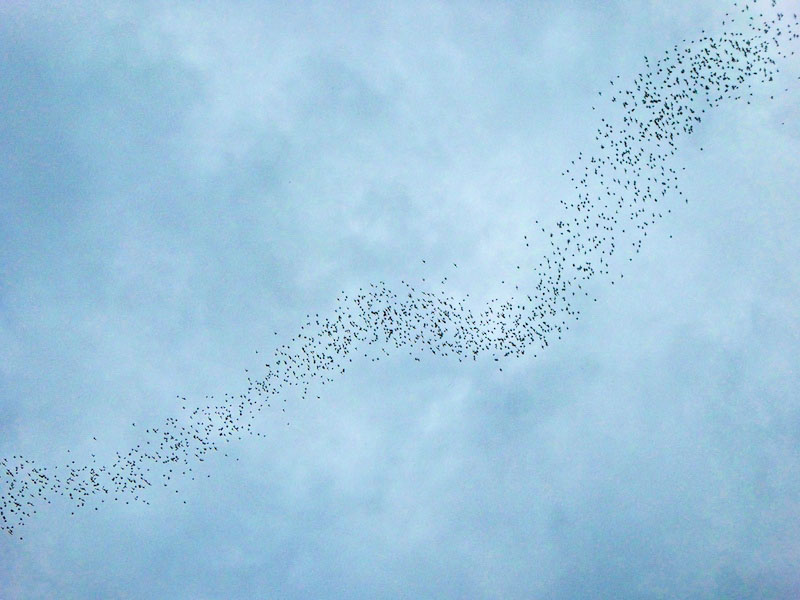 Bats exodus from Deer Cave at Mulu National Park
Bats exodus from Deer Cave at Mulu National Park
It was dark and humid, with the smell of bat guano becoming stronger and stronger. Sebastien looked up in the dark and said:
“We have over 3 million bats sleeping on top of our heads and we are basically walking under one big giant toilet!”
Stefan turned round to face Sebastien and saw far away in the light, the familiar face of Abraham Lincoln carved out in the cave entrance. He said to Sebastien (giggling to himself):
“If all those deers and cave salamanders can eat it then it’s probably not that bad. Get rid of that ridiculous handkerchief and just get used to the smell!”
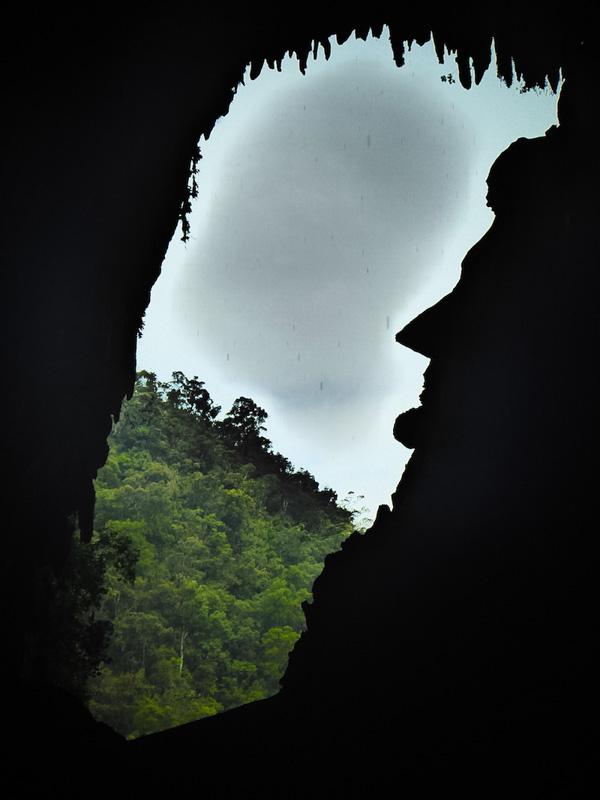 Abraham Lincoln rock shape at the Deer Cave entrance
Abraham Lincoln rock shape at the Deer Cave entrance
We were visiting the Deer Cave, the largest cave passageway in the world, located in Gurung Mulu National Park (or just Mulu NP for short), in Sarawak, Malaysia Borneo.
The Deer Cave at Gunung Mulu National Park
At 122m high and 174m, the cave mouth is large enough to fit the entire Statue of Liberty.
The Deer Cave is famous for its large wrinkle-lipped and horseshoe bats population of over 3 million, hanging from the ceiling. This explained the strong smell of guano inside.
Guano, simply put is bat pooh. It is an important source of nutrition for many of the cave species due to its high levels of minerals like nitrogen, potassium and phosphate. A large deer population used to come and feed on the high guano levels here, hence the name. The deers no longer come here but the name remained.
The bats release their guano in the early hours of the morning before resting and after retuning from a night out hunting. It’s this exodus of bats at sunset as they set off to hunt, which is extremely famous and is what brought us to the Deer Cave in the first place.
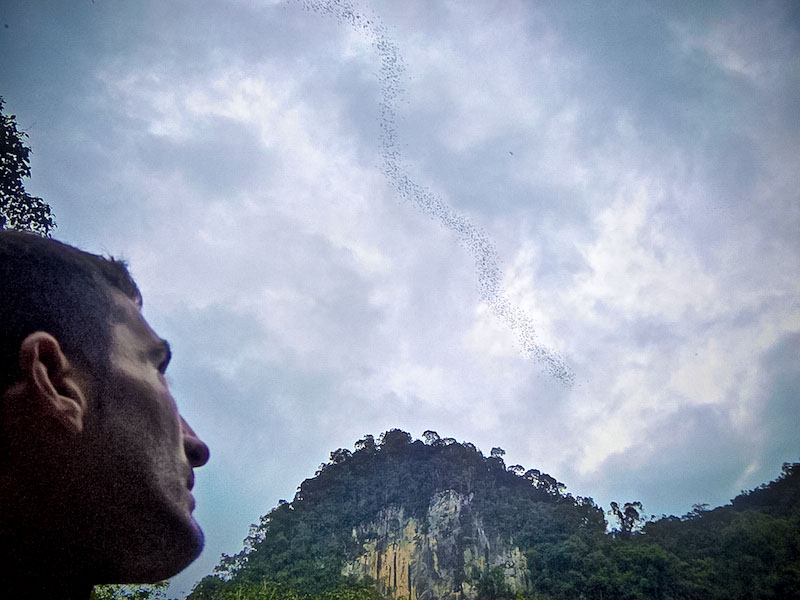 Stefan watching the bats in formation
Stefan watching the bats in formation
The Bats Exodus from the Deer Cave
Each evening, crowds gather by the mouth of the Deer Cave to watch the dramatic performance put on by the bats as they leave in organised groups to go hunting.
We visited on a very rainy August day and after a long day of hiking in the rain, we were worried the bats would not put on a show for us as they avoid going outside when it’s wet.
In spite of this, we gathered at the outdoor round theatre by the Deer Cave entrance, waiting for the show.
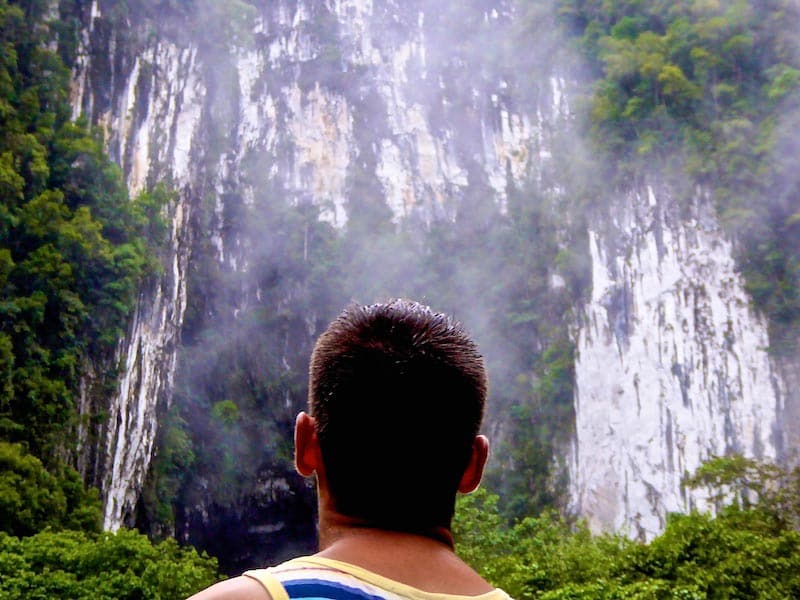 Sebastien waiting for the bats exodus at the Deer Cave entrance
Sebastien waiting for the bats exodus at the Deer Cave entrance
Suddenly, the rain stopped!
And the exodus began.
The bats gathered in their numbers at the cave entrance. Then, in a very organised manner, they exited in waves, one by one, in a large ring shaped formation circling higher and higher up the cliff face, moving out across the rainforest in a spiral shape. The sight resembled a giant DNA shape moving across the sky. A truly astonishing phenomena to witness.
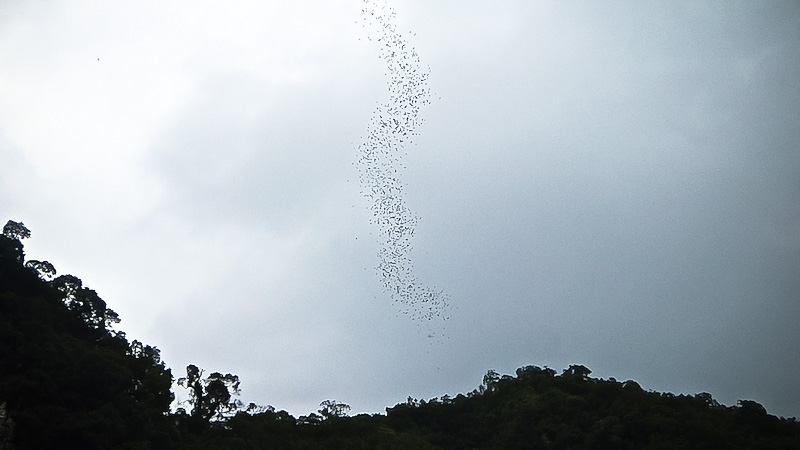 Giant DNA Bat exodus from the Deer Cave at Mulu National Park
Giant DNA Bat exodus from the Deer Cave at Mulu National Park
The bats continued in this way for almost an hour: each group lining up and waiting their turn to spiral out of the Deer Cave to go hunting in this giant DNA shape.
The large DNA shape formed by the bats in the sky is to create a threatening looking shape to ward off any predators. They are believed to travel up to 100km away from the cave towards the coast for meals of insects, washed down with seawater, then return in the early morning hours to rest.
The bats prefer night-time to hunt in order to avoid predators who are mostly active during the day light hours, and also to take advantage of the abundance of insect species active at night.
Did we say we got lucky?
Just as the final bats made their exodus, the rain, as if by magic, started pouring down heavily once again. It was almost as if the skies closed up in that 5:30pm window to let us watch this dramatic performance.
The Mulu National Park was a remarkable jungle experience and the bats exodus definitely something worth witnessing.
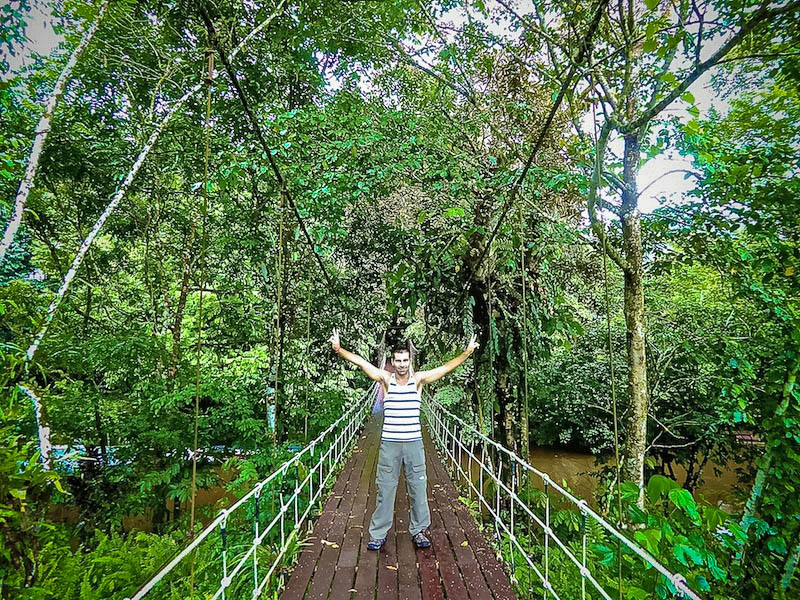 Sebastien in the Mulu National Park rainforest
Sebastien in the Mulu National Park rainforest
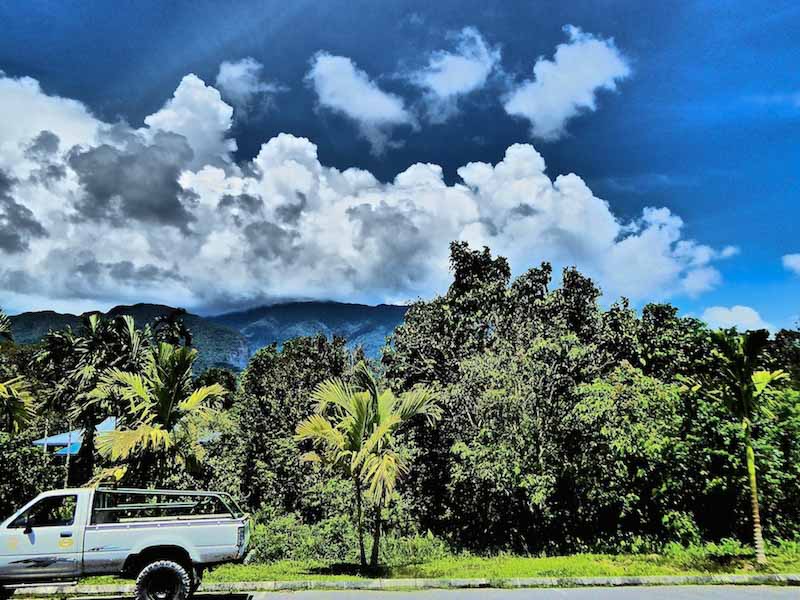 Surrounding area of the Mulu National Park
Surrounding area of the Mulu National Park
[tabs]
[tab title=”Practicalities” icon=’entypo-layout’]
The Mulu NP has been a UNESCO World Heritage Site since 2000 and is the largest national park in Sarawak. It’s located just South of Brunei, right in the heart of the Borneo rainforest:
The bats’ exodus from the Deer Cave is only accessible via a guided tour arranged at the Mulu National Park front desk.
The cost to enter the Mulu National Park is 30 Ringgits (SG$10 / US$7) per person.
The entire guided tour to the Deer Cave costs an additional 30 Ringgits (SG$10 / US$7) per person.
This is the rainforest tropical climate after all, so we highly recommend packing these essential items:
Trekking shoes
Raincoat (heavy downfalls are really unpredictable)
Torch (for the dark caves)
Insect repellent
Other Points to Note:
Internet access is extremely limited here so use this as an Internet break.
Very limited internet is available at the main café of the national park for a small fee (but rarely works). Alternatively the Mulu Marriott has quite good working Wi-Fi.[/tab]
[tab title=”Best Time to Visit” icon=”entypo-light-up”]
Weather in Mulu: Mulu is not strongly affected by the monsoonal seasons that most of Southeast Asia experiences, so there is no time of year to avoid going.
Peak Season: However, June to September is the busiest period, so booking accommodation in advance during these months is highly recommended.
[/tab]
[tab title=”Where to Stay” icon=”entypo-suitcase”]
1) Mulu National Park
You can stay in the camp itself in the following type accommodation options, more details for which can be found on the national park’s website: http://mulupark.com/accommodation
Deluxe Garden Bungalow: with air con, en suite bathroom and patio, from 260 Ringgits (SG$87 / $62)
Standard Longhouse room: with air con, en suite bathroom from 210 Ringgits (S$70 / $50)
Dorms: there is a 20 beds dorm with fan and shared bathroom from 52 Ringgits (S$18 / $13)
2) The Mulu Marriott Resort & Spa
The Mulu Marriott Resort & Spa is a good high-end option located around 5 minutes drive away. They offer a free shuttle service to/from the park for guests.
Rooms in their longhouse style wooden huts start from 470 Ringgits (S$156 / $112).
They have an excellent buffet for guests and outdoor pool to relax in after a day in the rainforest.
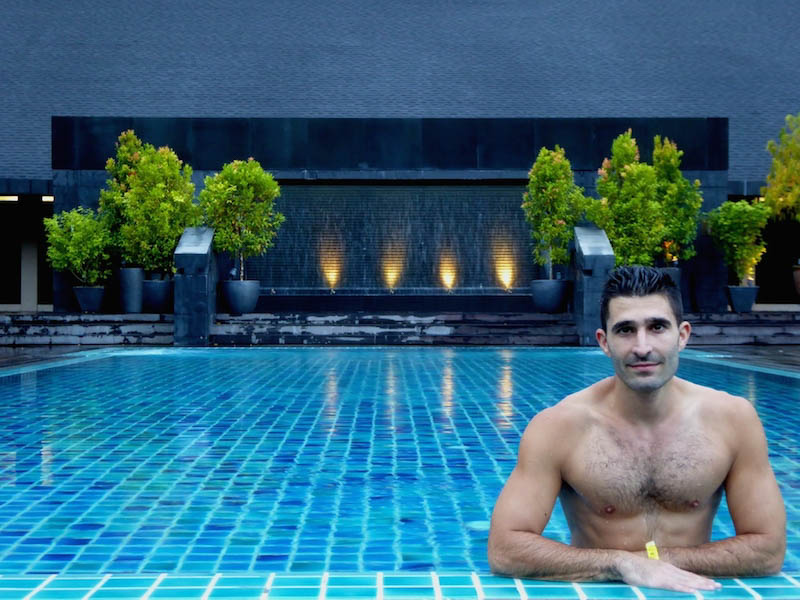 Stefan at the Mulu Marriott pool
Stefan at the Mulu Marriott pool
[/tab]
[tab title=”Getting There” icon=”entypo-address”]Best way to get to Mulu: There is an airport with flights to/from Kuala Lumpur via one of the three main transport hubs in Malaysia Borneo: Kuching, Miri or Kota Kinabalu.[/tab]
[/tabs]
About the Authors

Stefan Arestis and Sebastien Chaneac are the authors of The Nomadic Boys, a travel blog documenting their exciting travels and food hunts across the world since they left London in 2014. They started with the Trans-Siberian railway and are now happily eating their way through Asia.
Follow their journeys: